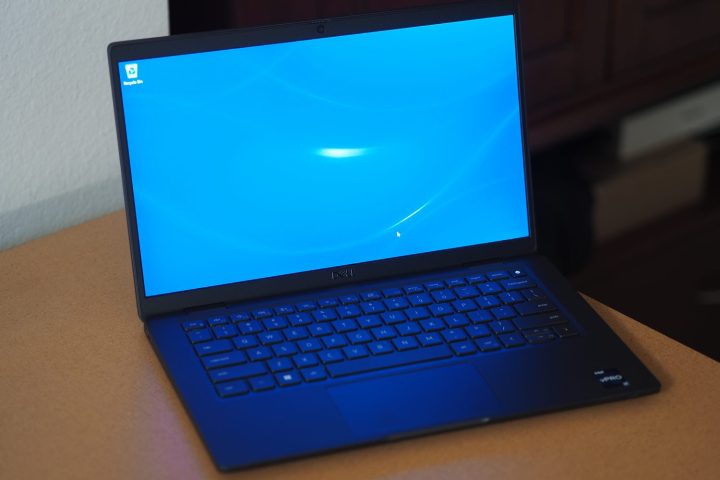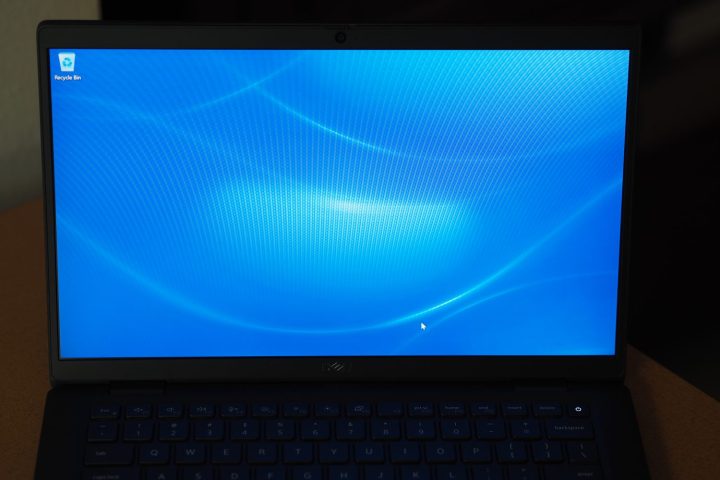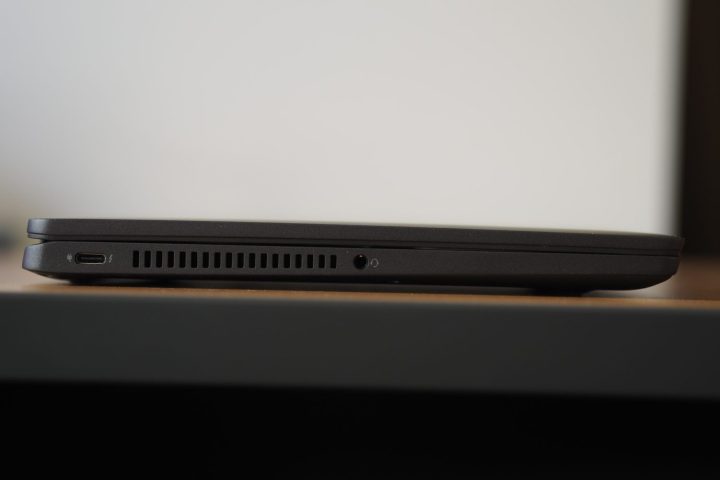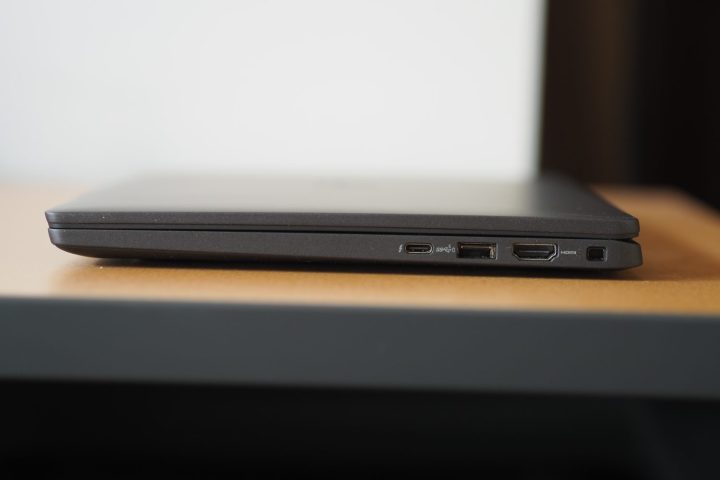“The Dell Latitude 7330 Ultralight is certainly lightweight, but it's slower than other Intel 12th-gen laptops, its battery life suffers, and its business features are lacking.”
- Extremely lightweight
- Strong enterprise management
- Good keyboard
- Bright and high-contrast display
- Old-school 16:9 display
- Expensive
- Below-average battery life
- Missing key privacy and security features
Business laptops aren’t all the stuffy, button-up affairs they’re often known for. High-end machines are continuing to push the envelope, and now offer businesspeople comparable designs and features to mainstream devices.
Dell’s Latitude 7330 13-inch Ultralight is a good example. It’s extraordinarily light — which is something just about anyone could appreciate.
However, Dell limited the Ultralight version to the point where some of the most critical business features are missing. And it’s not fast enough or long-lasting enough to make for a compelling laptop in general, despite its light weight.
Price and configurations
I reviewed a high-end configuration of the Latitude 7330 Ultralight (UL) with an Intel vPro processor and an old-school 16:9 display.
The Latitude 7330 Ultralight version has limited configurations compared to its heavier siblings. For example, there’s no 4G LTE WWAN option, there’s only one 16:9 Full HD (1,920 x 1,080) IPS display to choose from, the webcam is limited to 720p with no infrared camera for Windows 11 Hello support, and the battery is just 41 watt-hours compared to 58 watt-hours.
The entry-level model is $1,766 for an Intel Core i5-1235U non-vPro CPU, 8GB of RAM, and a 256GB PCIe SSD. The high-end configuration is $2,499 for a Core i7-1265U vPro, 32GB of RAM, and a 512GB PCIe SSD. My review configuration was the next-highest configuration, $2,265 for the Core i7-1265U vPro, 16GB of RAM, and a 512GB SSD.
Dell has another business-class 13-inch laptop, the Latitude 9330, that includes a more modern 16:10 display and isn’t nearly as light. It runs a few hundred dollars more than the Latitude 7330 similarly configured.
The Lenovo ThinkPad X1 Carbon Gen 10 is a competitive laptop, albeit a 14-inch model, that’s also relatively thin and light. It’s several hundred dollars less than the Latitude 7330, even with faster CPUs and better displays. Finally, the HP Elite Dragonfly G3 is around the same price as the Latitude 7330, albeit without Intel’s vPro and a smaller SSD. It’s just as lightweight.
Design

The Latitude 7330 is available in three options of materials: aluminum, carbon fiber, and magnesium alloy. I reviewed the magnesium version, dubbed the Latitude 7330 UL, which weighs just 2.13 pounds. That’s light enough to make it onto our list of lightest laptops. It’s thin, but not amazingly so, at 0.67 inches, and its large top and bottom bezels mean it’s not the smallest 13-inch laptop around in terms of its footprint on the table.
It’s wider and slightly less deep than the 2.2-pound Elite Dragonfly G3 that’s 0.65 inches thick, but that laptop has a larger and taller 13.5-inch 16:10 display. It’s also wider and slightly less deep than the Latitude 9330, which has a 13.3-inch 16:10 display, weighs 2.8 pounds, and is 0.55 inches thick. Finally, while the 14-inch ThinkPad X1 Carbon Gen 10 is wider and deeper, it’s thinner at 0.60 inches and weighs just 2.48 pounds — more than the Latitude but with a larger display. Ultimately, the Latitude 7330 UL stands out for its weight but not for its thickness or the size of its chassis.
Magnesium is a strong metal, but it’s not as stiff as aluminum. The Latitude 7330 UL, therefore, has some flexing in the keyboard deck and its lid bends awkwardly, showing off some LCD discoloration. That doesn’t make it a poorly built laptop, but it doesn’t feel as solid as all-aluminum machines like the Dell XPS 13 Plus and the HP Spectre x360 13.5. The hinge allows the lid to open about halfway with one hand, but then it stiffens and you’ll need the other hand to open it all the way. It does keep the display firmly in place during heavy typing sessions. I’ll note that the magnesium alloy makes for a softer touch than aluminum, although it might feel more like plastic to some people.
Aesthetically, the Latitude 7330 UL is about as minimalist as they come. The lines and angles are simple, and only the chrome Dell logo on the lid adds any flair. There’s nothing wrong with simplistic designs if they’re exceptionally streamlined and attractive, but this one is boring. The Latitude 9330 has that more streamlined look, while the Lenovo ThinkPad X1 Carbon Gen 10 sports the iconic and attractive ThinkPad aesthetic. For my money, the HP Elite Dragonfly G3 is a sleeker and better-looking laptop.
Ports and connectivity
Connectivity is good, with two USB-C ports with Thunderbolt 4, a USB-A 3.2 Gen 1 port, a full-size HDMI port, and a 3.5mm audio jack. We’re missing an SD card reader, and the Ultralight version doesn’t offer the optional Smartcard reader and eSIM. Wireless connectivity is up to date with Wi-Fi 6E and Bluetooth 5.2, but again the Ultralight version doesn’t have the optional WWAN support of the aluminum version.
One nice feature is Dell’s new ExpressConnect technology that lets you connect to two wireless networks simultaneously for greater speed, and the laptop can be configured to connect to the best available network.
Performance
As far as I could tell working through Dell’s very confusing configurator, the Latitude 7330 UL can be configured with one of two 12th-gen Intel U-series CPUs. There’s the 15-watt 10-core (two Performance and eight Efficient), 12-thread Core i5-1235U running at up to 4.4GHz, and the Core i7-1265U that has the same core and thread count but goes a little faster at 4.8GHz and include Intel’s vPro technology. My review unit equipped the Core i7-1265U, which promised at least as fast performance as the Core i7-1255U (up to 4.7Ghz) laptops that I’ve recently reviewed.
In our benchmarks, though, the Latitude 7330 UL fell behind all the other Intel 12th-gen CPUs we’ve tested. That was true in Geekbench 5, our Handbrake test that encodes a 420MB video as H.265, and the video rendering benchmark Cinebench R23. The Latitude even fell behind in the PCMark 10 Complete benchmark, which tests a variety of productivity, multimedia, and creative tasks.
The Latitude 7330 UL did exhibit some throttling that likely limited performance. And the Dell Optimizer utility provided various thermal tuning modes, of which I tested the balanced and performance. Switching to performance mode made a modest difference in Geekbench 5 and Cinebench R23, and a more significant improvement in Handbrake. As usual, switching modes didn’t impact the PCMark 10 Complete score by much.
Overall, the Latitude 7330 UL’s performance was faster than Intel’s 11th-gen, but not up to the standards of 12th-gen machines. That doesn’t mean the laptop can’t handle demanding productivity workflows, but it’s not going to be as fast as competing — and in many cases, much less expensive — machines.
| Geekbench (single / multi) |
Handbrake (seconds) |
Cinebench R23 (single / multi) |
PCMark 10 Complete |
|
| Dell Latitude 7330 UL (Core i7-1265U) |
Bal: 1,727 / 6,335 Perf: 1,725 / 6,896 |
Bal: 177 Perf: 147 |
Bal: 1,530 / 5,015 Perf: 1,722 / 6,182 |
4,767 |
| Lenovo ThinkPad X1 Carbon Gen 10 (Core i7-1260P) |
Bal: 1,531 / 8,209 Perf: 1,580 / 8,342 |
Bal: 133 Perf: 138 |
Bal: 1,538 / 6,993 Perf: 1,538 / 6,783 |
4,982 |
| MSI Prestige 14 (Core i7-1260P) |
Bal: 1,505 / 10,041 Perf: 1,477 / 10,604 |
Bal: 114 Perf: 97 |
Bal: 1,553 / 8,734 Perf: 1,567 / 10,450 |
6,201 |
| Lenovo ThinkPad X1 Yoga Gen 7 (Core i7-1260P) |
Bal: 1,650 / 8,080 Perf: 1,621 / 8,544 |
Bal: 116 Perf: 120 |
Bal: 1,587 / 7,682 Perf: 1,611 / 8,078 |
5,537 |
| Lenovo Yoga 7i Gen7 (Core i7-1255U) |
Bal: 1,652 / 8,194 Perf: 1,692 / 8,443 |
Bal: 200 Perf: 141 |
Bal: 1,679 / 7,176 Perf: 1,748 / 7,701 |
5,211 |
| Asus Zenbook S 13 OLED (Ryzen 7 6800U) |
Bal: 1,417 / 6,854 Perf: 1,404 / 7,223 |
Bal: 112 Perf: 111 |
Bal: 1,402 / 8,682 Perf: 1,409 / 8,860 |
5,647 |
Forget gaming unless you’re playing older titles with low resolution and graphics. The Intel Iris Xe isn’t a fast GPU in the best cases, and the Latitude 7330 UL is among the slowest.
| 3DMark Time Spy |
Fortnite (1080p/1200p Epic) |
|
| Dell Latitude 7330 UL (Intel Iris Xe) |
Bal: 1,235 Perf: 1,489 |
Bal: 11 fps Perf: 12 fps |
| Lenovo ThinkPad X1 Carbon Gen 10 (Intel Iris Xe) |
Bal: 1,816 Perf: 1,820 |
Bal: 17 fps Perf: 16 fps |
| MSI Prestige 14 (RTX 3050) |
Bal: 4,438 Perf: 4,451 |
Bal: 23 Perf: 26 |
| Lenovo ThinkPad X1 Yoga Gen 7 (Intel Iris Xe) |
Bal: 1,899 Perf: 1,886 |
Bal: 17 fps Perf: 16 fps |
| Lenovo Yoga 7i Gen 7 (Intel Iris Xe) |
Bal: 1,790 Perf: 1,716 |
Bal: 18 fps Perf: 18 fps |
| Asus Zenbook S 13 OLED (Radeon graphics) |
Bal: 2,110 Perf: 2,213 |
Bal: 19 fps Perf: 19 fps |
Display

I immediately noticed that the Latitude 7330 UL’s 13.3-inch 16:9 Full HD (1,920 x 1,080) IPS display was bright with true blacks for an IPS display. Colors seemed dynamic without being oversaturated, and other than the old-school aspect ratio, I found the display quite good during my testing.
According to my colorimeter, my eyes didn’t deceive me. The display was incredibly bright at 503 nits, well above our 300-nit standard. Its contrast was excellent for an IPS panel at 1,650:1, which made black text pop on white backgrounds. Colors hit the premium display average at 95% of sRGB and 74% of AdobeRGB, although that average has been creeping upward lately. Accuracy was good at a DeltaE of 1.56, where less than 2.0 is considered good enough for creative work. Among our comparison group, the Latitude 7330 UL most closely matched the Lenovo ThinkPad X1 Carbon Gen 10, with the former being brighter and the latter having slightly wider colors.
Unfortunately, the Latitude Ultralight does not include options for touchscreens.
Productivity workers, at whom this laptop is aimed, will enjoy this display if they can live with the resolution and aspect ratio. Creators will want to look elsewhere, but then again, this isn’t a laptop meant for all-day video or photo editing.
| Brightness (nits) |
Contrast | sRGB gamut | AdobeRGB gamut | Accuracy DeltaE (lower is better) |
|
| Dell Latitude 7330 UL (IPS) |
503 | 1,650:1 | 95% | 74% | 1.56 |
| Lenovo ThinkPad X1 Carbon Gen 10 (IPS) |
411 | 1660:1 | 98% | 76% | 1.96 |
| MSI Prestige 14 (IPS) |
317 | 1820:1 | 97% | 72% | 3.67 |
| Lenovo ThinkPad X1 Yoga Gen 7 (IPS) |
386 | 1900:1 | 100% | 81% | 0.78 |
| MSI Summit E14 Flip (IPS) |
516 | 1320:1 | 100% | 89% | 1.10 |
| Lenovo Yoga 9i 14 Gen 7 (OLED) |
406 | 28380:1 | 100% | 95% | 0.87 |
| Lenovo IdeaPad Slim 7 Carbon (OLED) |
397 | 27590:1 | 100% | 96% | 0.88 |
Two downward-firing speakers provide the audio and put out a surprising amount of volume, with zero distortion and clean mids and highs. There was even a touch of bass.
The speakers were good enough for watching Netflix and casual music listening, although action movies and more demanding music tastes will demand a good pair of headphones.
Keyboard, touchpad, and webcam

The keyboard’s keycaps are slightly small, but the key spacing is generous enough, making it easy to hit the right letters. The switches are firm with a snappy bottoming action, meaning that if you like a little more pressure, you’ll like this keyboard. It might be a bit much if you’re accustomed to lighter keys. I’d rate it behind the best laptops, including the Lenovo ThinkPad X1 Carbon Gen 10’s lighter and even snappier version.
The touchpad supports Windows 11’s multitouch gestures well enough, and its surface is comfortable. It’s a bit on the small side, though, thanks in part to the shorter display and a general lack of space on the palm rest.
There’s also no Windows 11 passwordless login support. If you want an infrared camera for facial recognition or a fingerprint reader, you’ll need to choose one of the heavier models. That’s particularly disappointing for a business laptop, where security is often an important factor.
Finally, the webcam is just 720p. Again, there’s a price to be paid for the lighter chassis — a Full HD webcam and infrared camera is not an option on the Ultralight.
Privacy and security
Dell builds several privacy and security tools into its Latitude machines, including its SafeBIOS to help avoid hacking and Dell Encryption Enterprise. There’s also a variety of other enterprise management tools including Intel Active Management Technology (AMT) for remote management and Intel Hardware Shield for hardware-enhanced security. Those are best supported by an Intel vPro chip, which my review unit was equipped with.
Because my machine lacked an infrared camera, it did not support the onlooker detection, Look Away Detect (which dims the screen based on user behavior), and ExpressSign-In wake on approach tools that other Latitude 7330 models support. The sole nod to privacy on the Ultralight model is a sliding physical shutter for the webcam.
Battery life

The Ultralight version of the Latitude 7330 is limited to a 41-watt-hour battery, whereas the other models can be equipped with 58 watt-hours. The display is just Full HD, and it uses a 15-watt CPU, so I was hopeful that I’d see at least decent battery life.
In our suite of battery tests, though, the Latitude 7330 UL fell about an hour below average across the board. In our web browsing test that cycles through a handful of complex websites, it managed just seven hours, and in our video test that loops a local Full HD Avengers trailer, it hit 10.5 hours. Finally, in the PCMark 10 Application test that best indicates productivity battery life, the Latitude made it to 8.5 hours. That’s less than each of the laptops in our comparison group and below average in general.
The Latitude 7330 UL is unlikely to get you through a full day of productivity work unless your tasks are light on the CPU. Anything more and you’ll be pulling out your charger.
| Web browsing | Video | PCMark 10 Applications |
|
| Dell Latitude 7330 UL (Core i7-1265U) |
6 hours, 55 minutes | 10 hours, 33 minutes | 8 hours, 33 minutes |
| Lenovo ThinkPad X1 Carbon Gen 10 (Core i7-1260P) |
7 hours, 39 minutes | 14 hours, 34 minutes | 10 hours, 42 minutes |
| Lenovo ThinkPad X1 Yoga Gen 7 (Core i7-1260P) |
10 hours, 10 minutes | 16 hours, 12 minutes | 10 hours, 33 minutes |
| Lenovo Yoga 9i 14 Gen 7 (Core i7-1260P) |
9 hours, 10 minutes | 12 hours, 45 minutes | 8 hours, 32 minutes |
| HP Spectre x360 13.5 (Core i7-1255U) |
9 hours, 58 minutes | 13 hours, 59 minutes | 10 hours, 52 minutes |
| Asus Zenbook S 13 OLED (Ryzen 7 6800U) |
8 hours, 4 minutes | 13 hours, 13 minutes | N/A |
Our take
The Latitude 7330 Ultralight sounds like a great idea. Take a solid business laptop and construct a version with lighter materials, making it one of the lightest laptops you can buy. But Dell compromised too much, stripping off some of the features that would be most compelling to its target market.
It doesn’t help that performance is at the low end of its class, and its battery life is less than average. Yes, it’s a very light laptop, but that’s not enough to justify its high price compared to some compelling alternatives.
Are there any alternatives?
The Lenovo ThinkPad X1 Carbon Gen 10 is also very light, given its 14-inch display. It offers similar business features, is faster, and gets better battery life. It’s a solid competitor.
Lenovo’s Yoga 9i Gen 7 is an excellent alternative if you don’t need those (sometimes missing) business features. It’s gorgeous, well-built, and has a stunning display. It’s also faster and less expensive.
Finally, I always recommend Apple’s MacBook Pro 14 as an option. Again, if you’re not plugging into an enterprise, you won’t find another laptop that’s as fast with such excellent battery life, along with the most solid build available. And it’s not much more expensive, if at all.
How long will it last?
The Latitude 7330 UL has some slight bending and flexing, which is common in a magnesium chassis. But, that doesn’t mean it’s not durable enough for years of service. It’s reasonably well-equipped for the near future as well. Dell offers a 3-year warranty with the Latitude, which is welcome.
Should you buy it?
No. There are better business laptops available that are only slightly heavier. The Latitude 7330 UL just makes too many compromises for its light weight.





